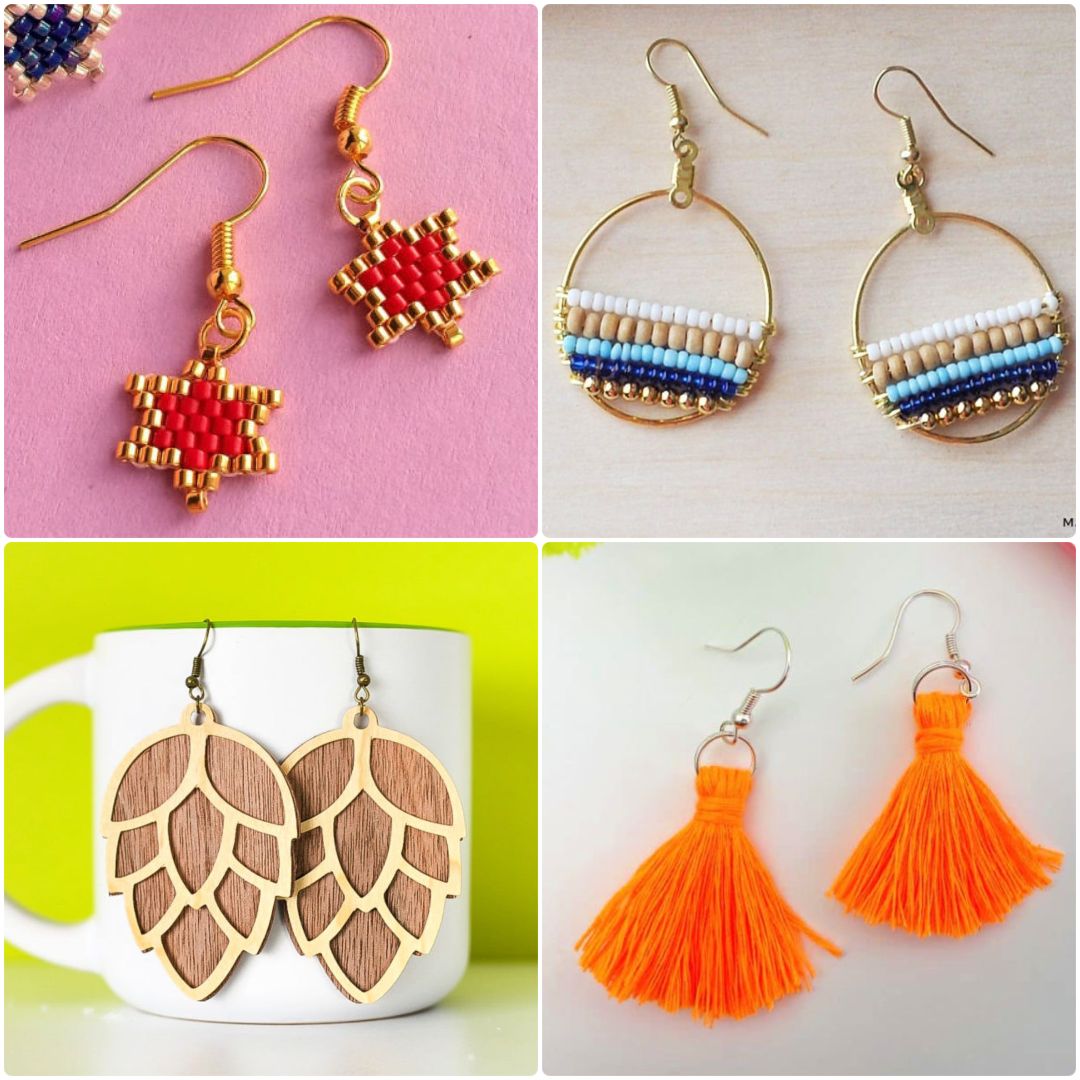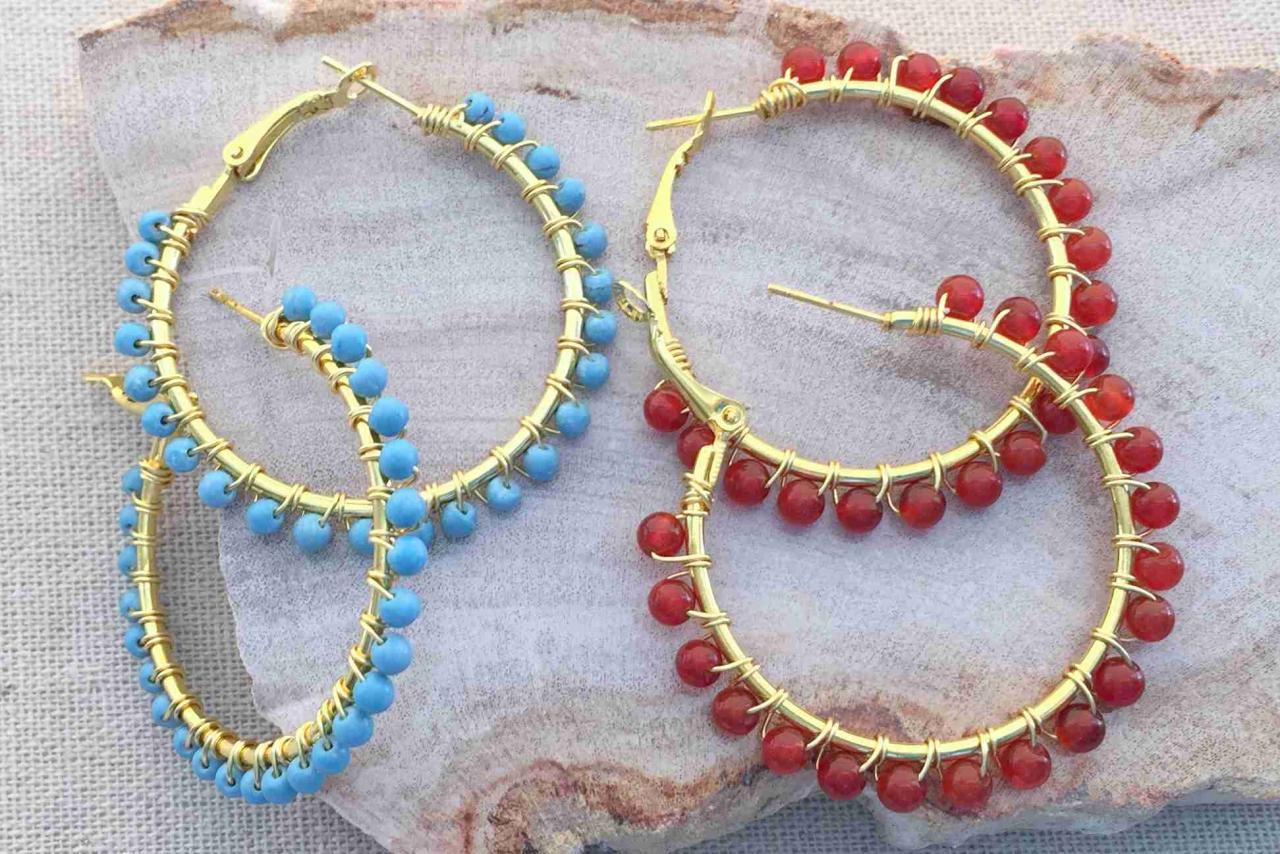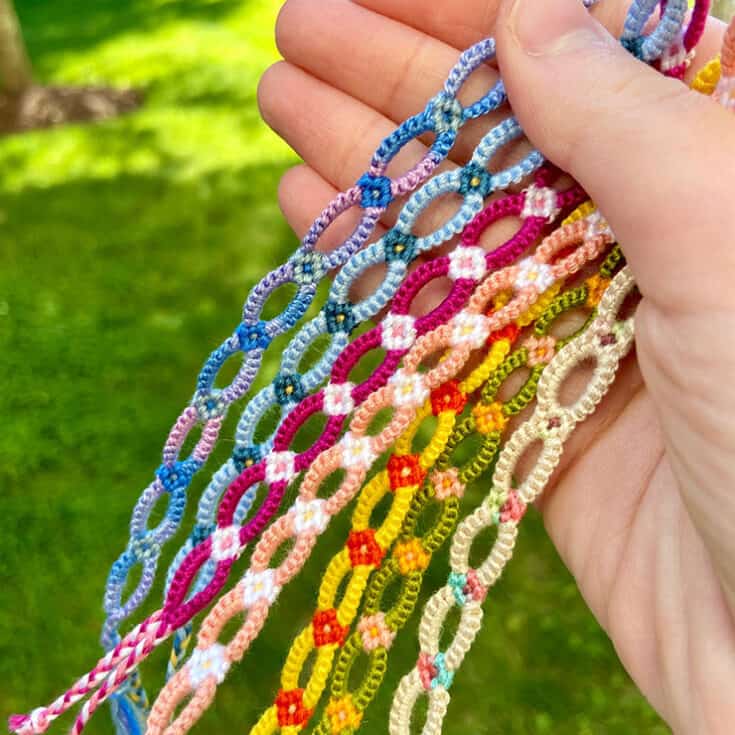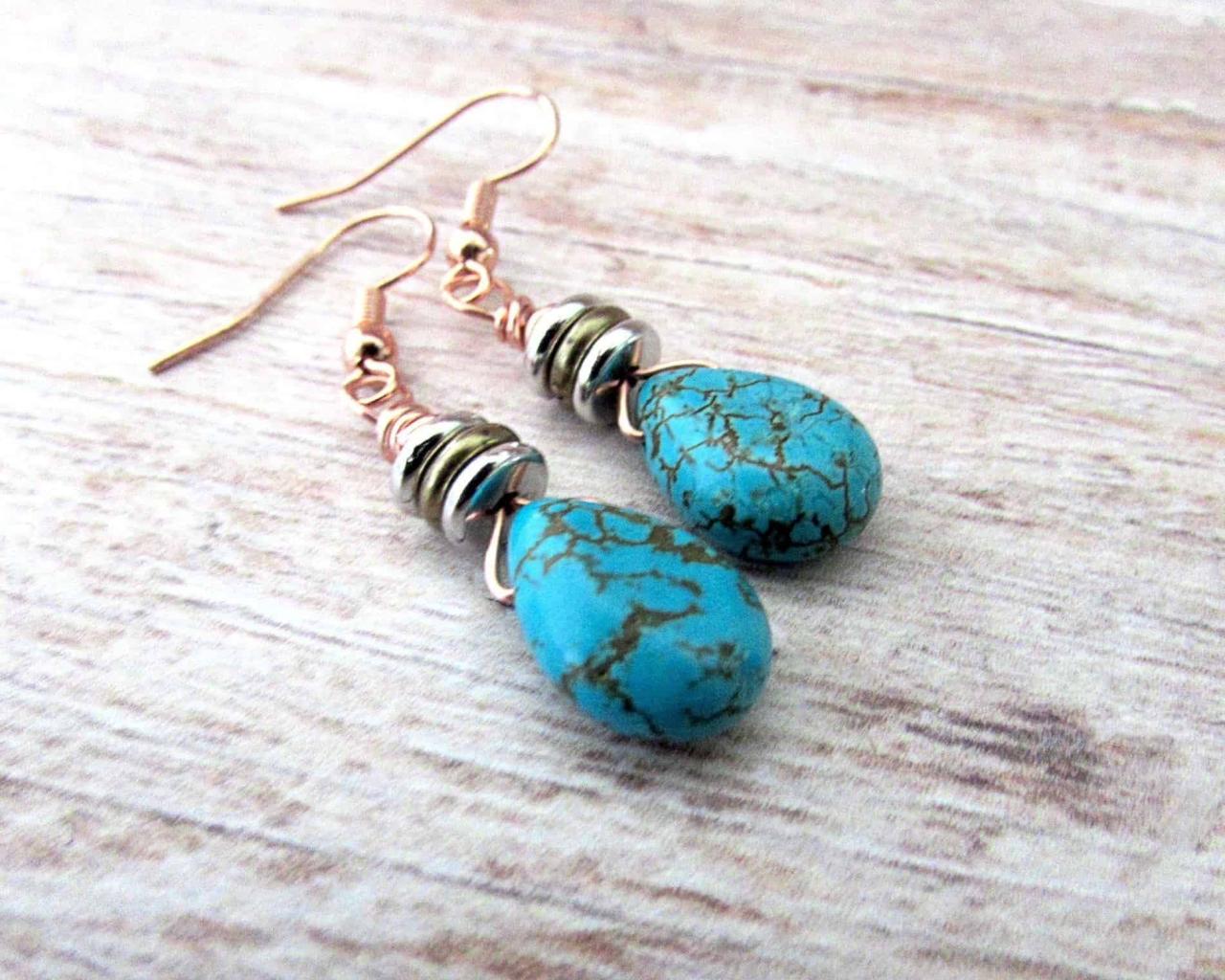Homemade earrings offer a unique way to express your personal style and creativity. From simple studs to elaborate dangles, the possibilities are endless. Making your own earrings allows you to choose the materials, colors, and designs that best reflect your taste, creating pieces that are truly one-of-a-kind.
This guide will walk you through the process of crafting beautiful earrings, from gathering the necessary materials and tools to mastering basic and advanced techniques. We’ll explore different earring designs, discuss finishing touches, and provide tips for safety and care. Whether you’re a seasoned crafter or a beginner, this comprehensive resource will inspire you to embark on your own earring-making journey.
Basic Earring Designs

Creating earrings from scratch allows you to express your personal style and craft unique pieces that perfectly match your outfits. While the possibilities are endless, some basic designs serve as a great starting point for beginners. This section will guide you through creating simple earring styles, including studs, dangles, and hoops, using basic techniques.
Stud Earrings
Stud earrings are the most basic and versatile earring style. They are typically small and simple, consisting of a post that goes through the earlobe and a backing that holds the post in place. The design of the stud itself can vary greatly, from simple round shapes to intricate patterns.
Here’s how to make basic stud earrings:
- Choose your materials. You will need earring posts, earring backs, and the material you want to use for the stud itself. Popular materials include polymer clay, metal clay, resin, and beads.
- Create the stud shape. This can be done using a variety of techniques, depending on the material you are using. For example, you can roll polymer clay into a ball and flatten it, or you can cut metal clay into a desired shape.
- Attach the earring post. Once your stud is complete, you will need to attach the earring post. For polymer clay or resin, you can insert the post while the material is still soft. For metal clay, you will need to use a drill to create a hole for the post.
- Attach the earring back. Once the post is attached, you can add the earring back to secure the stud in place.
Dangle Earrings
Dangle earrings are a bit more elaborate than stud earrings, featuring a pendant that hangs from the earlobe. The pendant can be made from a variety of materials, such as metal, beads, stones, or fabric.
Here’s how to make basic dangle earrings:
- Choose your materials. You will need earring hooks, jump rings, and the material you want to use for the pendant.
- Create the pendant. This can be done using a variety of techniques, depending on the material you are using. For example, you can wire wrap beads, create a polymer clay charm, or cut metal into a desired shape.
- Attach the jump ring. Once your pendant is complete, you will need to attach a jump ring to it. This will allow you to connect the pendant to the earring hook.
- Attach the earring hook. Open the jump ring and attach it to the earring hook. Close the jump ring to secure the pendant to the hook.
Hoop Earrings
Hoop earrings are a classic style that is both trendy and timeless. They can be made from a variety of materials, including metal, wire, and even fabric.
Here’s how to make basic hoop earrings:
- Choose your materials. You will need wire or metal that is strong enough to form a hoop. You will also need pliers to bend and shape the wire.
- Cut the wire. Cut the wire to the desired length for your hoop. The length of the wire will determine the diameter of the hoop.
- Bend the wire into a circle. Use your pliers to bend the wire into a circle. Be sure to leave a small gap in the circle so that you can connect the ends.
- Connect the ends of the wire. Once the circle is formed, use your pliers to connect the ends of the wire. You can either solder the ends together or use a crimp bead to secure them.
Earring Shapes and Design Methods
| Shape | Design Methods |
|---|---|
| Round | Wire wrapping, polymer clay rolling, metal clay shaping, resin casting |
| Square | Wire bending, polymer clay sculpting, metal clay cutting, resin casting |
| Teardrop | Wire bending, polymer clay sculpting, metal clay shaping, resin casting |
| Triangle | Wire bending, polymer clay sculpting, metal clay cutting, resin casting |
Finishing Touches
Adding finishing touches to your homemade earrings elevates their appearance and durability. These final steps ensure your creations are polished, protected, and ready to be worn.
Polishing and Sealing
Polishing and sealing enhance the appearance and longevity of your earrings. Polishing removes any rough edges or imperfections, creating a smooth and refined finish. Sealing provides a protective layer that prevents tarnishing, discoloration, and damage.
- Polishing: Use a polishing cloth or buffing wheel to gently smooth out any rough spots or uneven surfaces. This step is especially important for metal earrings.
- Sealing: Apply a sealant, such as a clear acrylic varnish or resin, to protect the earring components. This helps to prevent oxidation, scratches, and wear and tear.
Adding Embellishments, Homemade earrings
Adding embellishments to your earrings is a great way to personalize them and add a touch of flair. You can use a variety of materials, such as beads, crystals, charms, or even fabric scraps.
- Beads: Beads are a popular choice for adding color, texture, and sparkle to earrings. They come in a wide range of shapes, sizes, and materials.
- Crystals: Crystals add a touch of elegance and sparkle to earrings. They are available in a variety of colors and cuts.
- Charms: Charms are small decorative pieces that can be attached to earrings to add personality and meaning.
- Fabric Scraps: Fabric scraps can be used to create unique and eye-catching earrings. They can be sewn, glued, or wrapped around earring components.
Attaching Earring Findings
Earring findings are the components that connect the earring to the ear. They are typically made of metal and come in a variety of styles, including hooks, posts, and clips.
- Hooks: Hooks are the most common type of earring finding. They are simple to attach and easy to wear.
- Posts: Posts are typically used for stud earrings. They are inserted into the ear and secured with a back.
- Clips: Clips are a good option for people who have sensitive ears or prefer not to pierce their ears. They are attached to the earlobe with a spring mechanism.
- Wire Wrapping: Wrap the earring finding wire around the earring component, creating a secure and decorative attachment.
- Jump Rings: Connect the earring finding to the earring component using a jump ring, a small circular piece of wire that can be opened and closed.
- Glue: Use a strong, clear adhesive to attach the earring finding to the earring component.
Proper Care and Maintenance
Proper care and maintenance ensure your homemade earrings last longer and maintain their beauty.
- Store Properly: Store your earrings in a dry, airtight container or pouch to prevent tarnishing and damage.
- Clean Regularly: Clean your earrings with a soft cloth or a jewelry cleaning solution to remove dirt and debris.
- Avoid Harsh Chemicals: Keep your earrings away from harsh chemicals, such as perfumes, lotions, and hairspray.
- Handle with Care: Handle your earrings gently to avoid bending or breaking them.
Inspiration and Resources
The beauty of homemade earrings lies in the endless possibilities for creativity and self-expression. Finding inspiration and resources is key to unlocking your potential and crafting unique pieces that reflect your personal style.
Online Resources and Communities
The internet offers a wealth of resources for aspiring earring makers. Online communities, blogs, and social media platforms provide a platform for sharing ideas, tutorials, and inspiration.
- Pinterest: Pinterest is a treasure trove of earring designs, featuring everything from minimalist to bohemian styles. You can find inspiration from other crafters, discover new techniques, and save images for reference.
- Instagram: Instagram is a vibrant platform for showcasing your work and connecting with other earring makers. Use hashtags like #earrings, #handmadejewelry, and #jewelrymaking to find inspiration and connect with a community of like-minded individuals.
- Etsy: Etsy is a marketplace for handmade goods, including earrings. Browse through the listings to see what other artists are creating and get ideas for your own designs.
- YouTube: YouTube is a great resource for learning new earring-making techniques. Search for tutorials on specific styles, materials, or techniques to expand your skills.
Books and Tutorials
There are many excellent books and tutorials available that can teach you the fundamentals of earring making and inspire you with new designs.
- “Jewelry Making for Beginners” by Karen Hull: This book provides a comprehensive guide to jewelry making, including earring designs, techniques, and materials.
- “The Beading Bible” by Lisa Kanarek: This book is a comprehensive resource for beading techniques, including earring designs and patterns.
- “The Complete Book of Wire Jewelry” by Tammy Honaman: This book focuses on wire jewelry making, including earring designs, techniques, and projects.
Summary: Homemade Earrings
Creating homemade earrings is not only a rewarding craft but also a wonderful way to express your individuality and creativity. With the right materials, tools, and techniques, you can craft stunning pieces that reflect your personal style. Embrace the joy of making your own earrings, and discover the endless possibilities that await you in the world of handmade jewelry.
Homemade earrings are a great way to express your personal style, and they can be surprisingly easy to create. If you’re looking for inspiration for your next design, consider using a digital art program like procreate for windows to sketch out your ideas.
With its intuitive tools and beautiful brush sets, you can experiment with different colors, textures, and patterns to bring your earring designs to life.



